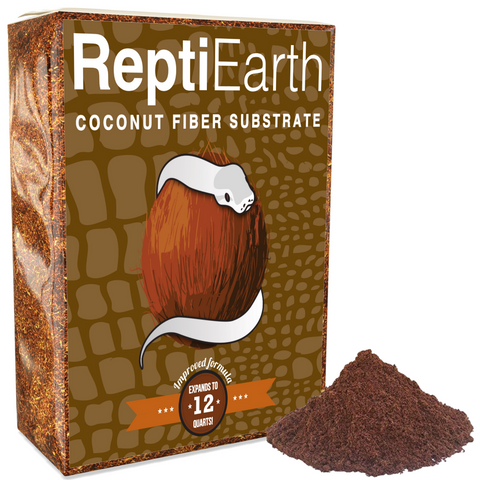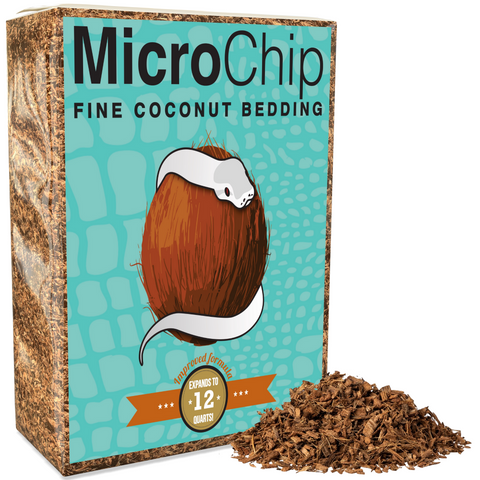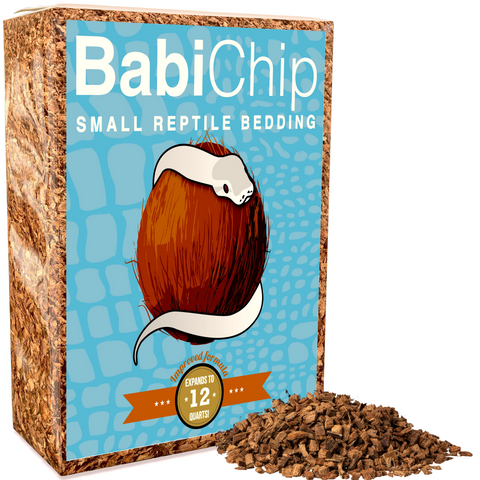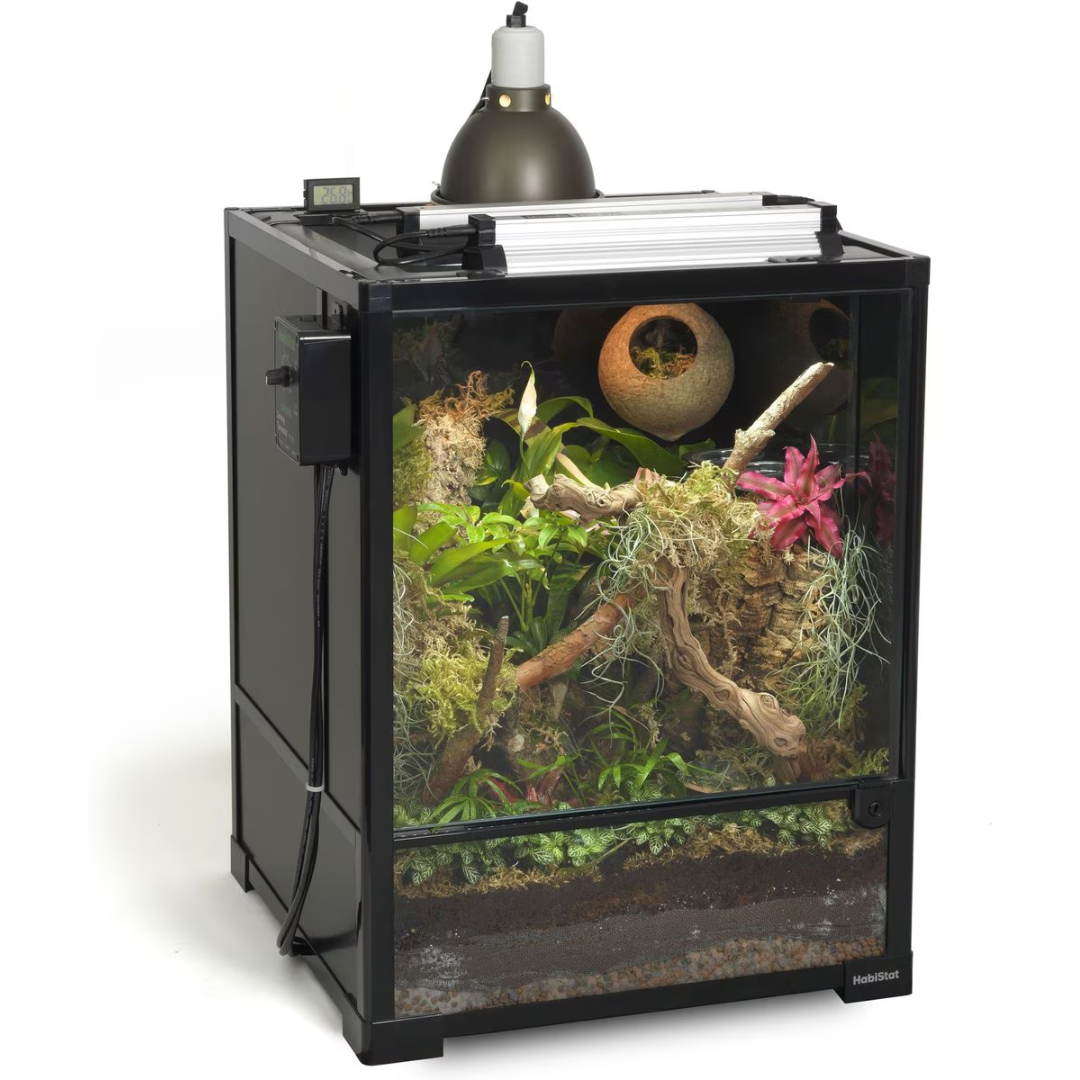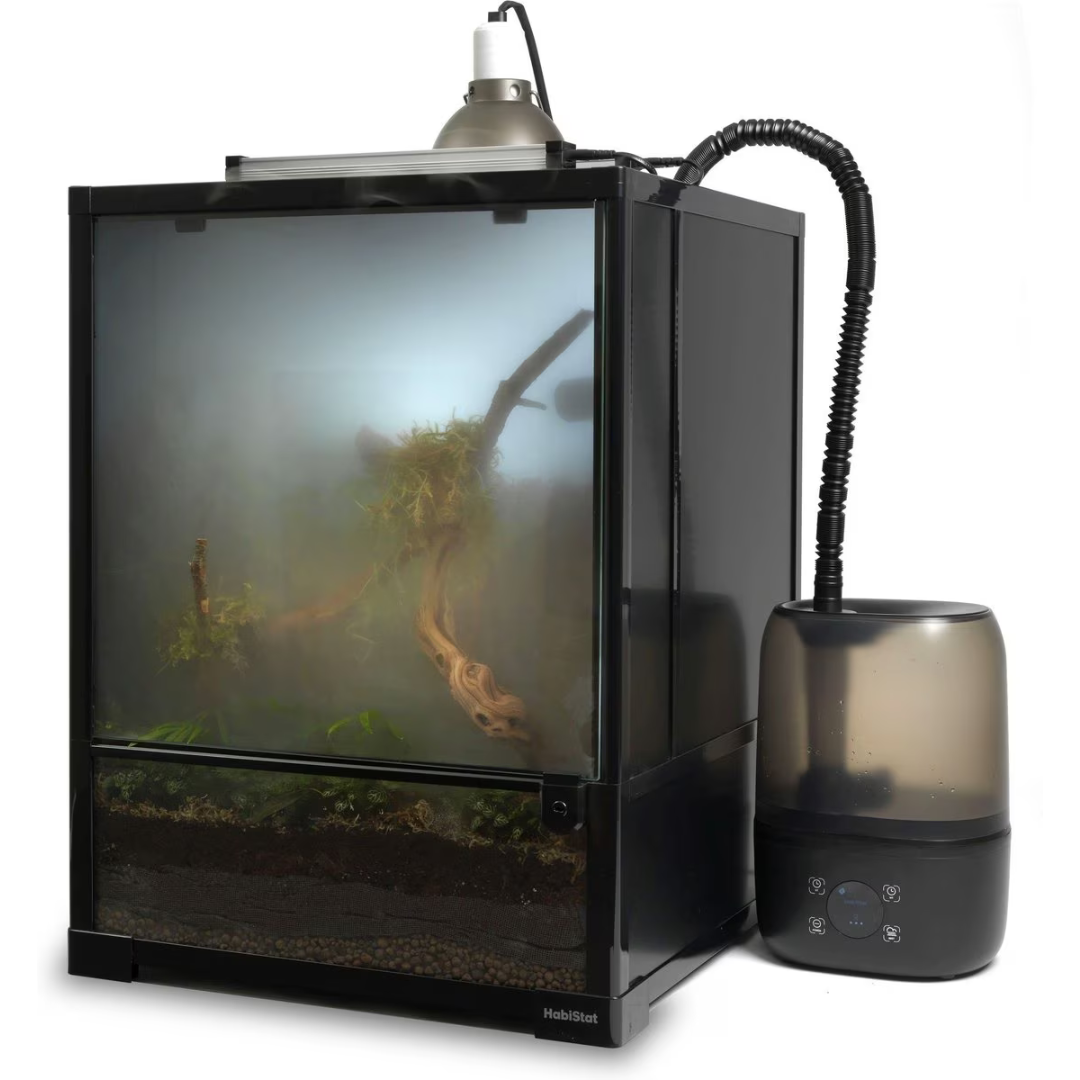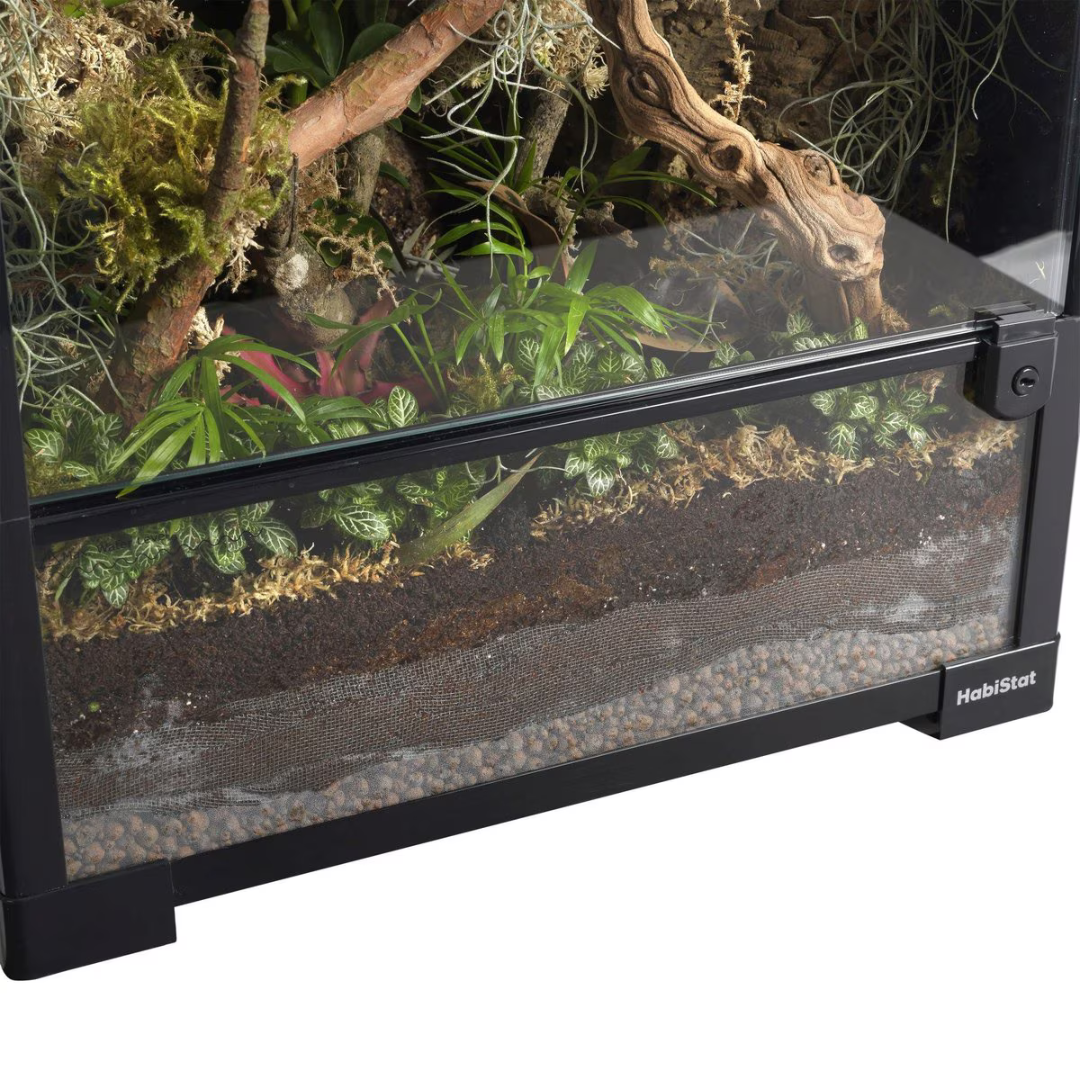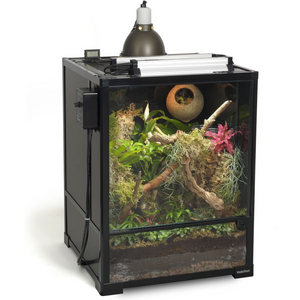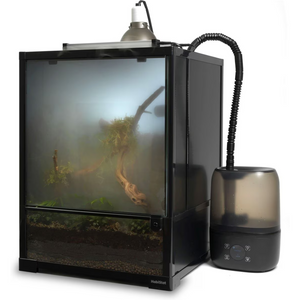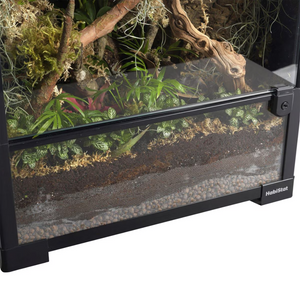Natural History
The golden spiny-tailed gecko is a desert-dwelling lizard native to the arid and semi-arid regions of northwestern Australia. This species follows a typical oviparous reptilian life cycle. Hatchlings emerge from eggs after an incubation period that typically ranges from 60 to 90 days, depending heavily on environmental conditions such as temperature and humidity. Females usually produce one to two eggs per clutch and may lay multiple clutches during a breeding season, which is largely dictated by rainfall and ambient temperature. Upon hatching, the juveniles are entirely independent, receiving no parental care. Growth is most rapid during the first year, with individuals reaching sexual maturity in about 18 to 24 months under optimal conditions. In the wild, they typically live 5 to 7 years, though individuals in captivity have been known to live up to 12 years with proper husbandry.
The golden spiny-tailed gecko is primarily nocturnal, taking advantage of cooler nighttime temperatures to forage and avoid predators. During the day, it seeks shelter in rock crevices, under debris, or inside tree hollows, depending on the habitat. When active, it uses stealth and short bursts of speed to ambush prey. Its diet consists mainly of small invertebrates, particularly insects such as beetles, ants, and moths, which it locates using excellent low-light vision and a well-developed sense of smell. The species is solitary and can be highly territorial, especially during the breeding season when males may engage in physical disputes or postural displays to fend off rivals. Communication among conspecifics includes subtle body language and occasional vocalizations such as squeaks or clicks. When threatened, the gecko may raise and curl its spiny tail as a warning display, and if necessary, it can shed its tail to distract predators—a process known as caudal autotomy. The regenerated tail is often shorter and lacks the original's spines.
In its natural ecosystem, the golden spiny-tailed gecko plays a critical role as both predator and prey. By feeding on a variety of insects and other arthropods, it helps regulate populations of pests that might otherwise burden the desert’s fragile flora. It is, in turn, preyed upon by larger reptiles, birds, and some mammals. This species occupies the mid-level tier of the desert food web and contributes to energy transfer within the trophic levels. Its spiny tail and camouflaged coloration provide effective defense and concealment in its rocky, sparsely vegetated habitat. Adaptations such as water conservation through efficient metabolic control, a tolerance for wide temperature fluctuations, and climbing adaptations like adhesion-enhancing toe pads make it well-suited to a challenging environment with extreme diurnal temperature changes. Understanding these behaviors and ecological traits is vital for replicating appropriate conditions in captivity and preserving natural behaviors critical to its health and welfare.
Conservation Status
The golden spiny-tailed gecko is currently classified as "Least Concern" on the IUCN Red List. This status reflects a stable overall population trend and a reasonably broad geographic distribution within its native range in the arid and semi-arid regions of Western Australia. The designation of "Least Concern" means that the species is not currently facing an immediate risk of extinction across its range. Populations are considered stable, and suitable habitat remains available in large enough quantities to support reproductive success and distribution continuity. However, this status does not imply that the species is free from all threats; rather, it indicates that, at present, the threats it faces are not yet severe enough to cause significant population declines on a global scale.
Despite this optimistic status, the golden spiny-tailed gecko does encounter several localized threats that could impact its long-term viability if not appropriately managed. Habitat destruction, primarily due to agricultural expansion, mining operations, and infrastructure development, poses a significant risk, especially given the species’ reliance on specific rocky outcrops and spinifex-covered habitats. Fragmentation of these habitats limits the gecko’s range and creates isolated populations, which can be more susceptible to environmental changes and genetic bottlenecks.
Climate change also presents a growing concern. Increases in temperature and shifts in precipitation patterns can alter the delicate microhabitats that this gecko depends on for thermoregulation, nesting, and foraging. Moreover, changing fire regimes associated with climate shifts and human land use may degrade spinifex grass layers, a key structural component of their native environment. While the species is somewhat resilient and adapted to arid conditions, extreme fluctuations and habitat alterations can outpace its ability to adapt, potentially leading to declines over time.
Another pressing issue is the impact of invasive species. Introduced predators such as feral cats and foxes are known to prey on small lizards and can exert significant pressure on local gecko populations. These predators are especially effective in fragmented landscapes where natural cover is limited and movement between habitats is restricted. Additionally, human collection for the pet trade, though limited compared to other species, has the potential to grow if not regulated, particularly given the gecko’s appealing coloration and unique morphology.
To mitigate these threats, several conservation strategies are already in place. In Australia, the golden spiny-tailed gecko benefits from the general environmental protection laws under the Environment Protection and Biodiversity Conservation Act, which regulates land use and the collection of native wildlife. Many regions within its distribution fall within protected areas and nature reserves, such as parts of the Pilbara and Gascoyne regions, which help preserve large swaths of suitable habitat from development.
Efforts in habitat restoration also support the species by promoting the regeneration of native vegetation, reducing invasive plant species, and managing controlled burns to mimic natural fire regimes. These practices help maintain the integrity of spinifex ecosystems and rocky habitats required for shelter and hunting. Meanwhile, feral predator control programs, especially those targeting feral cats, are increasing in scope and efficacy, further enhancing survivability for small reptiles in these regions.
Although there are currently no large-scale captive breeding programs dedicated specifically to the golden spiny-tailed gecko, the species has been successfully kept and bred in zoological and private collections under controlled conditions. These captive populations serve as genetic reservoirs that may prove vital should wild populations decline in the future. Continued study of these captive individuals also provides valuable insights into the species’ reproductive biology, stress responses, and habitat preferences—information crucial to future conservation planning.
Ongoing ecological monitoring is essential to detect early signs of population changes and identify emerging threats. Conservation reliance for the golden spiny-tailed gecko remains low at present, but proactive management will be necessary to ensure that its current status does not deteriorate. Long-term viability depends on maintaining intact ecosystems, preventing the spread of invasive species, and managing human activities to minimize their ecological footprint across this gecko’s range.
Native Range
The golden spiny-tailed gecko is endemic to a relatively restricted region in eastern Australia, primarily within parts of Queensland and northern New South Wales. Its distribution is geographically limited, with populations most often associated with the Brigalow Belt and adjacent woodland systems. These landscapes, shaped by a mosaic of dry sclerophyll forests, open woodlands, and scattered shrublands, support a range of endemic species adapted to their seasonal climates and structural complexity. Because the gecko’s range is not especially broad, even localized habitat changes can have significant effects on population health and connectivity.
The macrohabitat occupied by the golden spiny-tailed gecko includes dry forests, ironbark and cypress woodlands, and mixed eucalyptus habitats with moderately open canopies. These woodlands are often interspersed with brigalow, acacias, and native grasses, creating a patchwork of microhabitats. Within this environment, the gecko shows a strong preference for arboreal shelter sites, frequently occupying spaces beneath loose bark, inside hollow branches, or among dense foliage. These microhabitats provide critical protection from predators and environmental extremes, while also supporting its nocturnal, climbing lifestyle.
The species lives within a seasonal subtropical climate, marked by warm, humid summers and milder, drier winters. Rainfall is variable but tends to be higher during the summer wet season, creating pulses of insect activity that align with the gecko’s foraging behavior. Summer daytime highs often reach the upper 80s to 90s°F, with nighttime temperatures remaining relatively warm. Winters are cooler but still mild compared to more temperate parts of Australia, with nighttime lows that can occasionally dip near 50°F. Relative humidity shifts significantly between wet and dry seasons, often exceeding 70% in wetter months and dropping to 40% or lower during extended dry periods.
Elevation-wise, the golden spiny-tailed gecko is most often found at low to mid-elevation woodland systems, where tree diversity and bark structure provide abundant shelter options. Higher elevations are less frequently inhabited, likely due to cooler temperatures and reduced availability of preferred microhabitats. Critical environmental factors include access to crevices beneath bark, stable humidity pockets maintained in hollow logs and branches, and proximity to tree canopies that allow safe nocturnal foraging routes. Unlike many rock-dwelling geckos, this species is strongly tied to arboreal structures and does not thrive in open or treeless areas.
The golden spiny-tailed gecko’s reliance on structurally complex woodlands highlights its sensitivity to habitat fragmentation and land-use change. Removal of mature trees, loss of hollow-bearing branches, and conversion of woodland to pasture or cropland all pose significant risks. Its specialized use of arboreal shelters, combined with a relatively narrow geographic distribution, underscores its ecological vulnerability and the importance of conserving intact woodland ecosystems across its range.
Behavior
The Golden spiny-tailed gecko is a crepuscular to nocturnal species, with peak activity occurring during the early evening and overnight hours. In the wild, it emerges from rock crevices and under sheltered debris at dusk to forage and explore, retreating again before the heat of the day sets in. In captivity, this gecko maintains similar activity patterns, becoming most active when the enclosure lighting dims or turns off, indicating that light cues play an important role in regulating its behavior. Seasonal shifts in the wild influence activity levels, particularly during the cooler months when temperatures decline and food becomes less abundant. In southern regions of its native range, it undergoes a brumation period between late fall and early spring, during which the animal remains largely inactive and metabolic processes slow. Captive individuals may display similar dormant behavior if seasonal lighting and temperature gradients are mimicked appropriately.
Socially, the Golden spiny-tailed gecko is a solitary and territorial species. In its natural environment, individuals maintain defined home ranges centered around refuges in rocky outcrops or beneath logs. Males are particularly aggressive toward one another and will engage in ritualized displays—such as tail-arching and lateral body posturing—to establish dominance and deter intruders. Physical combat, while rare, may occur if space is limited or during the breeding season. Females tend to be less aggressive but display similar territorial instincts, especially when shelter sites are scarce. Breeding behavior involves pronounced male courtship, including head bobbing, tail vibrations, and tactile stimulation using the hind limbs. Once copulation occurs, females may lay a clutch of one to two calcified eggs in a protected, warm microhabitat. This species does not demonstrate any parental care; the hatchlings are fully independent upon emergence.
This gecko is highly responsive to environmental stimuli. A sudden drop or rise in temperature alters its behavior significantly. Individuals will seek shelter during high heat and emerge when temperatures fall within their preferred thermal range of 75 to 85°F. They rely heavily on moisture gradients and often become more active following rains in the wild, as these conditions increase prey availability and facilitate hydration. Light cycles are crucial in maintaining circadian rhythms, as prolonged light exposure can suppress feeding and rest patterns in captivity. Humidity fluctuations, particularly drops below adequate levels, can result in decreased activity and shedding complications. The species is also highly alert and reactive to vibrations and movement, using its acute vision and chemosensory abilities to detect potential threats or prey. When confronted by predators or human handlers, it may employ a suite of defensive behaviors including tail waving, open-mouth bluffing, and rapid retreat into crevices. Though non-venomous, it relies on cryptic coloration to blend into its rocky surroundings, significantly reducing the chance of detection.
Unique behavioral traits are key in identifying and distinguishing the Golden spiny-tailed gecko from other gecko species. Among the most notable is its distinctive tail display, wherein it arches the tail upward and exposes spiny protrusions when threatened. This display may act as both a deterrent to predators and a communication signal to conspecifics. The tail also serves an important role in fat storage, and geckos may autotomize (drop) it under extreme stress, though this defense is typically a last resort. Their locomotion is specialized for climbing and navigating uneven terrain; strong digits with adhesive lamellae allow them to traverse vertical rock surfaces efficiently. In hunting, this species practices a sit-and-wait strategy, relying on ambush rather than active pursuit. It remains motionless until prey such as insects ventures close, then rapidly strikes with precision.
In captivity, many of these behaviors remain intact, though some adapt in response to husbandry conditions. For example, aggressive displays may be more frequent in confined spaces where escape options are limited. The feeding response tends to be more consistent due to the regular availability of prey items, but enrichment in the form of live prey or varied feeding locations helps maintain natural foraging behaviors. Stress responses, including hiding and refusal to feed, can occur if enclosure parameters such as temperature, humidity, or lighting are inappropriate, or if the animal is housed with incompatible tankmates. Unlike in the wild where environmental stimuli are dynamic and unpredictable, captive geckos benefit from added environmental enrichment to prevent behavioral stagnation. This includes the use of multiple hides, climbing structures, and periodic variation in diet presentation. Overall, maintaining species-appropriate behavioral cues in captivity requires a deep understanding of their wild habits and finely tuned environmental controls.
Captivity Requirements
Enclosure Design
Golden spiny-tailed geckos are arboreal reptiles with strong climbing instincts and territorial behaviors. Enclosure design must prioritize vertical space, naturalistic structure, and proper security. Juvenile geckos may be housed in enclosures with minimum dimensions of 18 inches tall by 12 inches wide by 12 inches deep, although providing more climbing room is beneficial. Adult individuals require a larger space; a minimum of 24 inches tall by 18 inches wide by 18 inches deep is recommended. For a pair or small group, expand enclosure size accordingly, ensuring each gecko has its own basking and hiding areas to minimize stress and aggression.
Glass enclosures with screen-topped lids are often used due to their visibility and ventilation, but for more consistent heat and humidity regulation, PVC enclosures with screen ventilation panels are preferred. These provide better insulation and durability. Ventilation must be balanced—adequate airflow helps prevent respiratory issues, while retaining enough humidity for proper physiological functions. Door locks or secure fastenings are essential, as this gecko species is nimble and can exploit gaps to escape. Screen tops must be firmly attached and any sliding panels must close tightly to prevent escape routes.
The enclosure layout should replicate the gecko’s semi-arid to rocky woodland habitat. Install vertical climbing structures such as bark tubes, cork flats, and securely mounted branches. Elevate hiding spots to align with their natural preference for crevice-dwelling in cliffs or trees. At least two hides should be available: one moist hide to aid in shedding and hydration, and one dry hide for thermoregulation. A basking area should be situated near the top on a stable branch or platform beneath a heating element. The floor space should not be neglected; it can feature scattered rocks and a shallow dry substrate layer to simulate natural terrain. All fixtures must be stable and unable to collapse under the gecko’s movement.
Lighting and Heating
Golden spiny-tailed geckos are nocturnal but still benefit from appropriate UVB exposure during the daytime, as low levels of ultraviolet radiation contribute to healthy calcium metabolism and general well-being. A 5-7% UVB linear tube is ideal and should be mounted in a reflector fixture along the top third of the enclosure. Even though they are primarily active at night, many still bask briefly in indirect daylight or shaded areas. Position the UVB bulb 10–12 inches above elevated basking zones, ensuring filtered exposure through foliage or cover objects, simulating their natural behavior of receiving UVB through indirect contact.
Their enclosure should have an established temperature gradient to allow thermoregulation. The basking area should be maintained at 88°F to 95°F, supported by a ceramic heat emitter or halogen flood bulb paired with a thermostat for safety and consistency. The warm side ambient temperature should remain between 78°F and 85°F, while the cool side should not drop below 75°F during the day. Nighttime temperatures can fall to 70°F to 75°F without issue, as this mimics the reptile’s natural exposure to cooler desert nights. Avoid heat rocks, as these pose significant risks for burns and uneven heating. All heating elements must be thermostatically controlled and regularly monitored using digital thermometers with probe sensors at both basking and ambient levels.
Photoperiods should mirror natural seasonal light cycles. A 12-hour light and 12-hour dark cycle is appropriate year-round, but during winter months, reducing the light cycle to 10 hours can simulate seasonal changes and trigger natural behaviors such as decreased activity. This can be beneficial for breeding pairs, as it supports endogenous cycles. Light timing should be automated with timers to ensure consistency, which reduces stress and supports overall health.
Substrate and Enrichment
The substrate must accommodate both hygiene and behavioral needs while maintaining realistic representation of the gecko’s native habitat. The best options imitate the dry, loose soil or sand blend found in their environment. A mix made from ReptiEarth and play sand provides a clean, dust-free medium that retains minimal moisture while remaining safe for burrowing and spot-cleaning.
Enrichment is critical for this active, inquisitive species. Provide multiple textured surfaces and vertical climbing paths using natural cork bark, mopani wood, and hardwood branches. These allow exploration, basking, and shedding. Multiple hides placed at different vertical levels give geckos the option to choose hiding spots based on temperature and humidity. Rocky ledges or mounted slate tiles help replicate the heat-retaining surfaces they may use in the wild. Some individuals will use loose substrate to dig shallow scrapes beneath rocks or logs, particularly during thermoregulation or pre-shedding.
Stress reduction is achieved by maintaining visual barriers in the enclosure. Artificial foliage, bark flats, and textured walls offer visual security and reduce site-line contact between tankmates. Interactive enrichment such as occasional rearrangement of branches or new climbing areas encourages activity and keeps the gecko mentally engaged. Avoid over-cluttering the enclosure, though, as open vertical space is required for clear pathways between hides, basking, and feeding zones.
Humidity and Hydration
Golden spiny-tailed geckos originate from semi-arid habitats with fluctuating humidity, and their captive care must reflect this variability. Maintain daytime humidity between 30% and 50%, with slightly higher localized humidity provided via a moist hide or periodic misting. Nighttime levels may naturally increase slightly to around 60% as ambient temperatures drop. Use a hygrometer (preferably a digital device with a probe sensor) to monitor relative humidity both on the enclosure floor and near elevated hides.
To sustain proper humidity, lightly mist the enclosure once daily in the early evening, coinciding with the gecko’s emergence. This mimics dew formation and encourages natural licking of droplets from leaves and surfaces. Avoid spraying the entire enclosure to prevent standing water, which can cause bacterial growth. Instead, target misting near the moist hide and upper climbing surfaces. A humidity-retaining area is crucial, especially during shedding cycles. This can be created using a humid hide filled with moist sphagnum moss placed on the mid-warm side of the enclosure.
Hydration should be offered via a shallow, stable water dish that is changed daily. While many individuals drink dew or droplets post-misting, access to clean standing water supports ongoing hydration and encourages natural behaviors. Some geckos may be observed licking condensation or damp surfaces throughout the evening. Ensure the water dish is placed in a low-traffic area to avoid debris accumulation and is not directly beneath heat sources to prevent quick evaporation.
By combining proper humidity levels, misting routines, and reliable measuring tools, keepers can support healthy skin, respiratory function, and overall well-being in the Golden spiny-tailed gecko.
Diet & Supplementation
The Golden spiny-tailed gecko is primarily insectivorous, feeding on a diverse array of invertebrate prey in its natural arid and semi-arid habitat. In the wild, its diet primarily includes crickets, beetles, moths, caterpillars, ants, termites, spiders, and occasionally other small arthropods. This species may also opportunistically consume soft-bodied invertebrates such as centipedes or small scorpions when available. Although largely insectivorous, there have been occasional observations of individuals consuming small amounts of plant matter, possibly for hydration or mineral intake, but this is not a significant part of their diet.
The species is an active nocturnal forager, which means it engages in active searching behavior rather than ambush predation. At night, it emerges from its retreat sites and uses a combination of visual cues and chemical detection through tongue-flicking to locate prey. Like many geckos, it has excellent low-light vision, which allows it to detect motion and differentiate prey even under minimal illumination. Its accuracy in identifying and capturing prey is further enhanced by chemoreceptive abilities, particularly through the vomeronasal organ, allowing the gecko to sense chemical trails left by insects and other small prey.
Feeding behavior and prey selection may vary with age and season. Juvenile Golden spiny-tailed geckos have higher metabolic demands relative to their body size and require more frequent feeding, often every other day, with a focus on smaller, soft-bodied prey that is easier to digest. As they mature, adults typically feed two to three times per week and can handle a wider variety of prey items, including harder-bodied insects such as beetles. During cooler months or in periods of limited prey availability, these geckos may exhibit decreased feeding activity, correlating with lower metabolic rates or semi-dormant behavior.
In captivity, their diet must be thoughtfully replicated to ensure proper nutrition and long-term health. A base diet should consist of gut-loaded, nutritionally rich insects such as crickets, dubia roaches, black soldier fly larvae, and silkworms. Waxworms and mealworms can be offered occasionally but should not be staples due to their high fat content and lower calcium-to-phosphorus ratios. All prey should be appropriately sized—generally not exceeding the width of the gecko’s head—to prevent impaction or digestion difficulties. Calcium supplementation is crucial, particularly for juveniles and egg-laying females. A calcium carbonate powder should be lightly dusted on prey items at most feedings, while a multivitamin supplement containing vitamin D3 can be offered once or twice per week to ensure balanced micronutrient intake, especially for geckos kept indoors without UVB exposure.
Some challenges in replicating the wild diet in captivity include the limited variety of prey available through commercial sources and the absence of natural feeding stimuli. This can lead to dietary monotony and potential refuse of food by individuals that are either stressed or not adequately stimulated. Obesity is another common issue observed in captive specimens, particularly when they are overfed or offered energetically dense prey too frequently. Conversely, underfeeding or incorrect supplementation can result in malnutrition, leading to soft bones, lethargy, or reproductive failure.
To encourage natural feeding behaviors, keepers should mimic the gecko’s natural foraging patterns by offering live prey during evening hours when the gecko is most active. Rotating prey types regularly can stimulate interest and provide a more balanced diet. Using feeding tongs to simulate moving prey or releasing live prey into a naturalistic enclosure can promote hunting instincts. Environmental enrichment, such as adding bark pieces, leaf litter, or climbing surfaces, can improve activity levels and encourage exploratory and feeding behavior. Observation of individual feeding responses and adjustments in diet or environment based on their behavior is essential for providing optimal long-term care.
Reproduction
The Golden spiny-tailed gecko reaches reproductive maturity typically between 18 to 24 months of age, with females occasionally maturing slightly later than males. This species displays subtle sexual dimorphism; males tend to possess thicker tail bases, slightly broader heads, and more prominent femoral pores than females. During the breeding season, behavioral differentiation becomes more apparent, with males often displaying increased territoriality and distinct courtship behaviors. Courtship involves a series of tactile and visual signals including tail vibrations, lateral body flattening, and gentle biting, which function to both stimulate receptive females and establish pair bonding. Successful copulation typically occurs after prolonged courtship interactions, emphasizing the importance of compatibility and stress minimization during introductions.
To stimulate reproductive behavior in captivity, careful environmental manipulation is crucial. The Golden spiny-tailed gecko is native to semi-arid regions with defined seasonal cycles, so mimicking natural environmental transitions encourages breeding. A key factor is the adjustment of ambient and basking temperatures. During the simulated “winter” period, temperatures should be lowered for 6 to 8 weeks, with daytime gradients ranging from 72°F to 78°F and nighttime drops into the mid 60s°F. Reduced photoperiods of 10 hours of light per day during this time reinforce the seasonal cue. Following this brumation phase, gradually increasing the photoperiod to 14 hours and elevating the basking zone up to 95°F with ambient temperatures around 85°F stimulates hormonal changes associated with mating readiness. Concurrent elevation of humidity during this "spring revival" period is also beneficial, achieved by misting one side of the enclosure daily and providing access to a humid microclimate around potential nesting sites.
The Golden spiny-tailed gecko is oviparous, laying small clutches of two eggs per reproductive event. Mating occurs most successfully when individuals are housed in breeding-specific enclosures that balance the need for visible interaction with the ability to retreat. Providing ample visual barriers and hiding spots is essential to minimize stress, especially for females, who may respond negatively to persistent or aggressive males. Breeding enclosures should be at least 1.5 feet wide by 1.5 feet deep by 2 feet tall, with varied vertical structure to encourage natural behaviors. A moist nesting box filled with a damp substrate such as sphagnum moss or ReptiEarth must be present to stimulate oviposition. Geckos of this species are best bred in solitary pairs as group interactions often lead to dominance issues or mating interference. Carefully tracking the behavior of introduced pairs is necessary, as signs of refusal or persistent escape attempts by either individual typically suggest incompatibility.
Captive breeding of the Golden spiny-tailed gecko can present several challenges. Incompatibility between mates is not uncommon and often manifests through aggressive interactions or a lack of courtship engagement. In such cases, offering more gradual introductions—such as co-habiting the pair in adjacent enclosures with visual access before direct contact—can increase success. Stress is a significant impediment to reproductive success and may be caused by excessive handling, insufficient environmental complexity, or suboptimal microclimates. Utilizing naturalistic enclosures with climbing opportunities, multiple hideouts, and substrate depth for burrowing reduces stress and encourages natural breeding behaviors. Environmental mismanagement—particularly inconsistent temperature regulation and inappropriate photoperiod range—can suppress reproductive hormone cycles, so automated light and heating schedules are highly recommended. Ensuring that females are in robust health prior to breeding is also critical, as calcium or energy deficits can lead to fertility issues or egg retention. Supplementation with vitamin D3 and calcium, combined with a varied diet of gut-loaded feeder insects, should begin several weeks before introducing breeding pairs. By adhering to these evidence-based strategies and providing precise environmental control, breeders can significantly improve the likelihood of successful copulation and egg deposition in this species.
Incubation & Neonate Care
The golden spiny-tailed gecko is an oviparous species, meaning it reproduces by laying eggs rather than giving live birth. Females typically produce clutches of one to two eggs, which are laid in secure, hidden locations within the environment, such as beneath bark, in crevices, or in moist substrate. In captivity, females should be provided with a nesting area that mimics natural conditions. This can consist of a shallow container filled with slightly moist vermiculite or a ReptiEarth-sand mix at a ratio that permits the substrate to clump without being wet. Adequate nest sites not only encourage proper egg-laying behavior but also help reduce the risks of egg retention or egg binding, a potentially life-threatening condition.
Once eggs are laid, they should be carefully transferred to an incubator if artificial incubation is preferred. The ideal incubation temperature for golden spiny-tailed gecko eggs ranges between 78 and 84°F. Relative humidity should be maintained at approximately 70 to 80 percent to prevent desiccation of the eggs. Vermiculite or perlite is commonly used as an incubation medium due to its ability to hold moisture while promoting gas exchange. The incubation substrate should not be saturated with water; rather, it should maintain a damp consistency. Incubation typically lasts between 60 and 90 days, depending on the temperature.
As hatching nears, the eggs may begin to dimple slightly, signaling that the neonates are absorbing the last of their yolk reserves and preparing to emerge. Geckos hatch using an egg tooth to slit through the leathery shell, and may rest partially emerged for several hours before fully exiting the egg. Hatching can occur over a period of hours and should not be interfered with unless complications become apparent, such as extended periods without progress, which may indicate a weakened or malformed hatchling. Parental geckos in captivity do not exhibit any care toward the eggs or hatchlings and may even pose a threat to them. Therefore, eggs should be incubated separately, and hatchlings must be housed independently from adults to prevent stress, injury, or cannibalism.
Neonate enclosures should be set up to provide an appropriately scaled-down version of the adult habitat. A 10-gallon terrarium can accommodate a small group of hatchlings temporarily, though individual housing reduces competition and provides better observation of feeding and health. A humidity level of 50 to 70 percent supports healthy skin and shedding, while a thermal gradient including a warm side of around 85°F and a cool side in the mid 70s allows for thermoregulation. Nighttime temperatures can drop slightly but should not fall below 70°F. Hatchlings benefit from multiple hides, including a humid hide lined with damp sphagnum moss, to assist with shedding and provide security.
First meals can be offered 3 to 5 days after hatching, once the residual yolk has been absorbed and the digestive tract is functional. Appropriately sized insects, such as pinhead crickets or small fruit flies, should be dusted with calcium and vitamin D3 supplements at every feeding. Hatchlings should be fed daily during their rapid growth stage, with care taken to remove uneaten prey to reduce stress and potential harm. Hydration is critical in neonates; a shallow water dish should always be available, and enclosures should be misted lightly to encourage drinking behavior. Regular observation for signs of retained shed, lethargy, or failure to thrive is essential. Neonates are particularly sensitive and should be handled minimally to avoid stress and physical harm. As with adults, gentle handling techniques and hand sanitization between neonates help prevent cross-contamination or injury during maintenance routines.
By closely replicating the conditions found in the golden spiny-tailed gecko’s natural environment and adapting protocols developed through herpetological research, breeders and keepers can significantly improve hatching success and ensure the healthy development of neonates into robust, well-adjusted juveniles capable of thriving in captivity.
Conclusion
The golden spiny-tailed gecko is a highly specialized and ecologically significant reptile whose successful care in captivity requires an informed and holistic approach grounded in its natural history. Native to the rocky outcrops and arid woodlands of Australia, this gecko exhibits distinct behavioral, physiological, and environmental adaptations that directly shape its husbandry needs. From its nocturnal activity pattern and territorial disposition to its dependence on crevice-rich sandstone habitats and moisture-regulated microenvironments, every element of its biology points to the importance of replicating specific environmental parameters in captivity.
Captive care must address seasonal temperature and light variations, moderate ambient humidity, and access to elevated hiding areas that mimic its preferred crevice shelters. Proper thermoregulation through carefully managed basking gradients, UVB exposure, and seasonal cues is essential not only for general physiological health but also for stimulating natural behaviors, including reproduction and brumation. A nutritionally balanced, insect-based diet that mirrors its wild prey intake—combined with calcium and vitamin supplementation—is vital for musculoskeletal integrity, especially in juveniles and breeding females.
Housing should reflect the gecko’s vertical tendencies and include safe climbing structures, moisture-retentive hides, and textured furnishings that encourage exploration and aid in skin shedding. Stress management through environmental enrichment, secure hiding spots, and low-density housing further supports the species’ well-being. For breeding programs, environmental manipulations that parallel seasonal climatic shifts are key to triggering reproductive behaviors, while incubation practices must ensure proper temperature, humidity, and hygiene to deliver viable hatchlings.
Also significant is an understanding of the species' ecological and conservation context. Although currently classified as Least Concern, the golden spiny-tailed gecko faces localized environmental threats such as habitat fragmentation, invasive predators, and changing fire regimes. Captive management practices should aim not only to support individual specimens but also to mitigate potential pressures on wild populations through ethical sourcing, responsible breeding, and educational outreach that highlights the ecological role of this little-known species.
In summary, maintaining the golden spiny-tailed gecko in captivity requires more than basic reptile care—it demands a nuanced application of ecological insight, behavioral observation, and environmental control. With appropriate husbandry grounded in species-specific knowledge, keepers can successfully promote the health, longevity, and natural behaviors of this exceptional desert gecko while contributing to a broader appreciation for the complexity of arid-zone reptiles.



